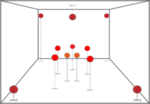Acousmatic Room Orchestration System
The Acousmatic Room Orchestration System (AROS) is a multichannel sound system design for the playback of sound and music using a multitude of speakers.[1] AROS was developed by the Swiss company Idee und Klang in 2005. Its underlying idea is based on the loudspeaker orchestra (or Acousmonium), which was established in the early 1970s by the ‚Groupe de recherches musicales' of Radio France, especially by the composer François Bayle.[2]
Overview
In an orchestra the spatial experience results from the fact that each musician plays his own part in a specific spatial location and on an instrument with a specific timbre and sound diffusion.The acoustic properties of the concert hall further influence the resulting sound experience.[3] Based on this idea, in AROS each sound element or part of a composition has got its own speaker and distinct location within the room. Unlike other multichannel sound systems such as 5.1 or Ambisonics, AROS does not generate or reproduce pre-recorded spatial information. Instead, it generates spatiality by incorporating the acoustic characteristics of the actual space.[4]
Setup and Functionality
Contrary to other 3D audio systems which usually rely on a circular or spherical speaker placement,[5] in AROS, as with its underlying loudspeaker orchestra, speakers are distributed across the whole space, i.e. mounted on walls, fixed to the ceiling, put on the floor or even inside objects. The wider the speakers are spread, the greater the spatial depth becomes. The parameter of physical distance is equally important as the direction or angle of a speaker. Moreover, the speakers need not point strictly towards the centre, they might deliberately be aimed at a wall to achieve a diffusion effect. Different speaker types can be applied, ranging from directional to 360-degree speakers and featuring different frequency ranges. Some of them might be just tweeters if they merely have to render the part of some high-frequency sounds within the composition.[6] The need for the speakers to be integrated into the architecture, in some cases even hidden away, sometimes calls for flexible solutions such as flat panel loudspeaker mounted behind walls, and also transducers inside of objects or underneath the floor might be appropriate.
Each speaker is driven individually and various panning methods have been implemented. In 2010, a stand-alone panning server called PS-1 was developed, based on the SPAT object of IRCAM.[7] This allows to mix 128 sources to 128 outputs. The automation data of the panning can be recorded in any DAW like Pro Tools, so any production or compositional environment suitable for the project may be chosen.

Applications
The first project in which the Acousmatic Room Orchestration System was applied on a big scale was at the BMW Museum in Munich, which opened its gates in 2008.[8] The museum was equipped with 600 speakers. Each area within the partially acoustically transparent exhibition space has its very specific sound architecture. In a similar fashion AROS was integrated in places such as the Imperial War Museum in London, the State Grid Pavillon at the Expo 2010 in Shanghai, or the Museum of Future Government Services in Dubai.

References
- De Marco, Ramon (2015). "Acousmatic Room Orchestration System (AROS)" (PDF). Proceedings of the 3rd International Conference on Spatial Audio.
- Bayle, François (1993). Musique Acousmatique Propositions – Positions.
- Hamasaki, Kimio; Van Baelen, Wilfried (2015). "Natural Sound Recording of an Orchestra with Three-Dimensional Sound". Audio Engineering Society Convention (138).
- De Marco, Ramon (2015). "Acousmatic Room Orchestration System (AROS)" (PDF). Proceedings of the 3rd International Conference on Spatial Audio.
- Pulkki, Ville (2001). Spatial Sound Generation and Perception by Amplitude Panning Techniques. Espoo: Helsinki University of Technology.
- Harrison, Jonty (Aug 1998). "Sound, space, sculpture: some thoughts on the 'what', 'how' and 'why' of sound diffusion". Organised Sound. 3 (2): 117–127. doi:10.1017/S1355771898002040.
- Jot, Jean-Marc; Warusfel (1995). "Spat: A spatial processor for musicians and sound engineers". CIARM: International Conference on Acoustics and Musical Research.
- Etherington, Rose. "BMW Museum by Atelier Brückner". Dezeen. Retrieved 14 May 2020.
External links
- Project description of the BMW Museum (Memento from November 19, 2010 in Internet Archive)
- Schweizer Klangkünstler komponieren für das renovierte BMW-Museum. In: Professional Audio News. From July 2008.
- Professional-System-Fachartikel (PDF file; 1,6 MB)